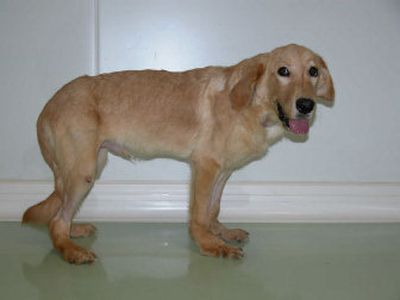Stem cell injections fight disease in dogs

NEW YORK – Stem cell injections worked remarkably well at easing symptoms of muscular dystrophy in a group of golden retrievers, a result that experts call a significant step toward treating people.
“It’s a great breakthrough for all of us working on stem cells for muscular dystrophy,” said researcher Johnny Huard of the University of Pittsburgh, who wasn’t involved in the work.
Sharon Hesterlee, vice president of translational research at the Muscular Dystrophy Association, called the result one of the most exciting she’s seen in her eight years with the organization. Her organization helped pay for the work.
She stressed that it’s not yet clear whether such a treatment would work in people, but said she had “cautious optimism” about it.
Two dogs that were severely disabled by the disease were able to walk faster and even jump after the treatments.
The study was published online Wednesday by the journal Nature. It used stem cells taken from the affected dogs or other dogs, rather than from embryos. The idea of using such “adult” stem cells from humans would avoid the controversial method of destroying embryos to obtain stem cells.
The Nature paper focuses on Duchenne muscular dystrophy, a muscle-wasting genetic disorder that affects only boys and occurs in about 1 in every 3,500 male births. It’s the most severe and most common childhood form of muscular dystrophy and the best-known. In theory, the stem cell treatment might also help other muscle dystrophies or even age-related muscle wasting, Hesterlee said.
Boys with Duchenne dystrophy have trouble walking as early as preschool, and nearly all of them lose their ability to walk between ages 7 and 12. Typically, they die in their 20s because of weakness in their heart and lung muscles. There is no known cure.
The dog study was done by Giulio Cossu, director of the Stem Cell Research Institute at the San Raffaele Scientific Institute of Milan in Italy, with colleagues there and elsewhere.
“We do not know whether this will work in patients,” Cossu said in a telephone interview. He said he hopes to start a small experiment in children in the next year or two.
The scientists worked with golden retrievers that suffer a crippling form of dystrophy very much like the human one. Researchers studied the effect of repeated injections into the bloodstream of a kind of stem cell extracted from blood vessel walls.
The best results appeared when the cells were taken from healthy dogs. But Cossu said scientists should pursue the possibility of genetically manipulating a patient’s own cells and using them instead. That way, patients wouldn’t have to undergo lifelong treatment to avoid rejection of donated cells.
In one of several experiments, three dogs that had not yet shown impairment in walking were injected five times, a month apart, with cells taken from other dogs.
One dog completely avoided symptoms and continued to walk well even five months after both the injections and the anti-rejection therapy were stopped.
A second dog also did well initially but died suddenly of a heart problem after just two months on the treatment. It’s not clear whether the problem had anything to do with the treatment, Cossu said.
The third dog showed partial protection, being able to walk and even run with a limp, but then progressively lost walking ability within a few days after the anti-rejection treatment was stopped.
The researchers also treated two dogs that were severely impaired by the disease. Both gained the ability to move much faster and to jump, and one was even able to run, although neither could use the hind legs normally.